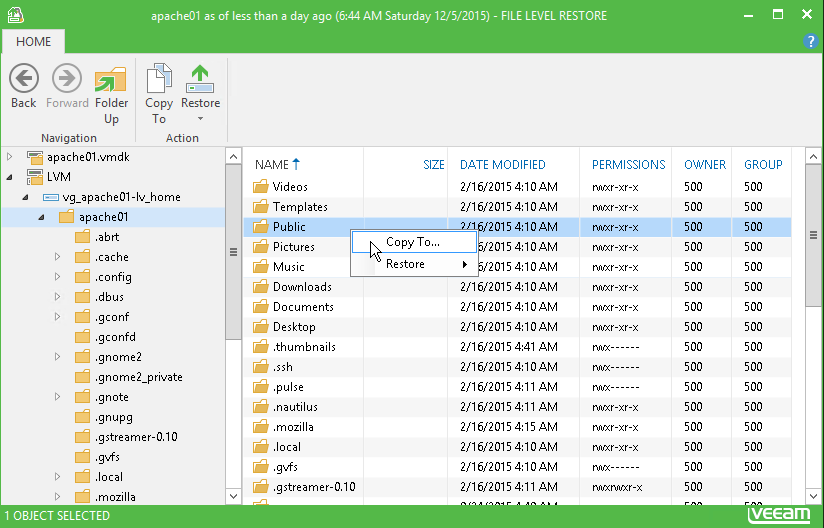When the restore process is complete, Veeam Backup Free Edition opens the Veeam Backup browser displaying the file system tree of the restored VM.
You can save the restored files and folders to their original location, new location or access files on FTP.
|
You can browse to the VM guest OS files and access restored files on the FTP only while the Veeam Backup browser with the restored files is open. After the Veeam Backup browser is closed, the VM disks will be unmounted from the proxy appliance. The proxy appliance will be deleted and the storage snapshot will be unmounted from the ESX(i) host (unless this storage snapshot is used by other restore operations). |
Saving Files to Original Location
To save files and folders to the original location, right-click a file or folder in the Veeam Backup browser and select one of the following commands:
- To overwrite the original file on the VM guest OS with the file restored from the backup, select Restore > Overwrite.
- To save the file restored from the backup next to the original file, select Restore > Keep. Veeam Backup Free Edition will add the RESTORED- prefix to the original file name and save the restored file in the same location where the original file resides.
To restore files to the original location, Veeam Backup Free Edition uses the account for VM guest OS access specified in the backup job settings. If this account does not have sufficient rights to access the target VM, you will be prompted to enter credentials. In the Credentials window, specify a user account to access the destination location (server or shared folder). You can use the account under which you are currently logged on or a different account.
Saving Files to New Location
To save files and folders to a new location:
- Right-click the necessary file or folder and select Copy to.
- In the Select Destination window, select a destination server (local or remote) from the list or provide a path to the shared folder.
- If you are recovering files to a Linux server, you can select the destination server from the list or add a destination server ad-hoc. To do this, scroll down the list of servers and choose Specify a different host at the end of the list. Follow the steps of the wizard to add a Linux server that will be used as a destination host.
The server you add ad-hoc will not appear in the list of managed hosts in Veeam Backup Free Edition: its purpose is to host the files that you recover. It will only remain visible in the Veeam Backup browser until all currently active file-level restore sessions are completed.
- If you are recovering files to a shared folder, specify a path to the destination folder.
- If you want to preserve original permissions and ownership for recovered files, select the Preserve permissions and ownership check box.
- After you click Restore, if prompted, in the Credentials window specify the user account to access the destination location (server or shared folder). You can use the account under which you are currently logged on or a different account.
|
To restore original permissions and ownership settings of restored files and folders, the account you have specified must have privileges to change the owner on the selected server or in the shared folder. |
Accessing Files over FTP
If you have chosen to enable FTP server on the FLR appliance, the restored file system will also be available over FTP at ftp://<FLR_appliance_IP_address>. Other users in the same network can access the FLR appliance and restore files they need.








